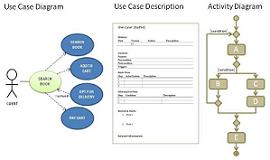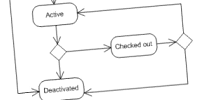|
The tools and techniques we use.
 The techniques our company mostly use are UML and use cases. To design UML we use tools such as Sparx Systems Enterprise Architect, Microsoft Visio, and other (less) known design tools.
The techniques our company mostly use are UML and use cases. To design UML we use tools such as Sparx Systems Enterprise Architect, Microsoft Visio, and other (less) known design tools.
To have an indication what the functionalities would look like in screens, we make drawings in Miscrosoft Visio, Balsamiq Mockups or Microsoft PowerPoint (without being limitative).
Commonly, we work in Scrum/Agile or SDLC (waterfall) project management environments. The software created by the developers are web or Windows applications developed in Microsoft .NET or Java with different kinds of database management systems behind (SQL Server, Oracle IBM DB2, 'Mainframe' and so on).
UML
 One of the most used techniques to model requirements is UML. Unified Modeling Language is a specification for specifying, visualizing, constructing and documenting the artifacts of software systems.
One of the most used techniques to model requirements is UML. Unified Modeling Language is a specification for specifying, visualizing, constructing and documenting the artifacts of software systems.
Key is re-use and object-orientation. A use case diagram is a graphical overview of functionalities and their relations. These diagrams are written out. Using an activity diagram the sequence of activities can be showed. Besides these other diagrams exist.
Other techniques
Different techniques exist for capturing requirements.
BPMN (Business Process Modeling Notation) is an other standard for modeling business processes using a graphical notation (which is similar to UML's activity diagrams). Goal is an understandable tool for as well business as technical people.
Volere Requirements Process (Robertson) provides a structure and guidlines based on experiences. It helps discovering and prioritizing requirements and describing them for stackholders.
With BPR (Business Process Reengineering) and BPI (Business Process Improvement) improvements to the performances of organizations are aimed. These are approaches and not really modeling techniques.
Business Analysis vs. Functional Analysis.
Many people confuse business analysis with functional analysis.
The study of the business and visualising its model is the basis to decide which parts of it shall be developed. Business analysis helps understanding the company’s activities, to make them more efficient and so, more cost effective.
Functional analysis is the process of analysing the functionalities and of specifying in detail the steps that should be taken to reach a successful result and how the system should react on negative outcome.
A picture is worth a thousand words. For this reason, a scheme or a screen sketch is a valuable element in business as well as in functional analysis.
|


 The techniques our company mostly use are UML and use cases. To design UML we use tools such as
The techniques our company mostly use are UML and use cases. To design UML we use tools such as  One of the most used techniques to model requirements is UML. Unified Modeling Language is a specification for specifying, visualizing, constructing and documenting the artifacts of software systems.
One of the most used techniques to model requirements is UML. Unified Modeling Language is a specification for specifying, visualizing, constructing and documenting the artifacts of software systems.